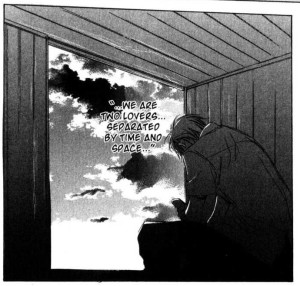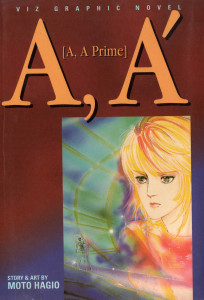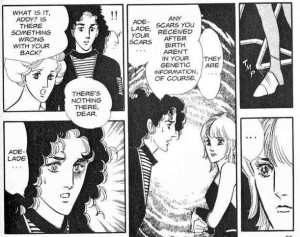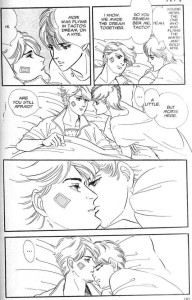SF Manga 101: The Voices of a Distant Star & A, A’ (A, A Prime)
Glenn Hough (gallyangel) is a nonpracticing futurist, an anime and manga otaku, and is almost obsessive about finishing several of the lists tracked on WWEnd. In this series on SF Manga Glenn will provide an overview of the medium and the place of science fiction within it.
As the lights dim and the previews end, it’s time to settle back with a favorite snack for a double feature. Since these two mangas are far shorter than normal, we won’t be here as long.
The Voices of a Distant Star was initially created by Makoto Shinkai who is one of those people anime otaku pay attention to. He’s not a newcomer anymore. Voices, as an anime, was one of the works which cemented his status in Japan and around the world as someone to watch. Mizu Sahara, which is just one of several pen names that Sumomo Yumeka uses, adapted the anime to manga. And finally, on my ninth blog, the gender bias in SF manga cracks. Yumeka is our first women.
I’m afraid we must acknowledge a gender bias here. Lady mangaka seem to write infrequently in the pure SF manga genre. If I was writing about magical realism, fantasy or high fantasy, I already would’ve talked about several efforts by both manga gods Rumiko Takahashi and the CLAMP quartet. But I’m doing SF. The ladies own other genres in Japan and seem to make infrequent forays into SF. And then, of course, the publishing houses here only want the best, or what will sell the best (that’s really the key) so this shrinks the available pool of possible SF by women even more. Add my own biases and lack of funds, and that shrinks the pool further. So, I’m neither dismayed nor surprised that it’s taken until the 9th blog to get to two female voices in SF manga. It’s really a matter of knowing that the bias is there, so specifically seeking out the exceptions, is the only real way to counter it.
This is what the publisher said about The Voices of a Distant Star:
To what distance would you go for your one true love? In a future filled with a boundless potential for interstellar peace and prosperity, Mikako joins a research team to explore the recent contact between humans and alien races. She ventures out into space, leaving behind Noboru, the one young man she loves. As she travels deeper into this new frontier, her only connection with her boyfriend is through cell-phone text messages. But the years pass, and Mikako barely ages in the timelessness of space–while Noboru grows older and considers moving on with his life… In this timeless romance between star-crossed lovers in the most tragic of settings, there are some places man may not be ready to go.
I’m sure you can see just how different this is from what I’ve blogged about before. This is a thought experiment in the Einstein mode. Noboru stays on Earth, while Mikako goes off into the universe at close to the speed of light. He ages years. She ages weeks. Everything revolves around their head and heart space. It’s loss, longing, and loneliness contrasted with the social standards of their society. What’s more important? that infrequent text message or the needs of today, coupled with the expectations of society? Einstein’s time dilation is there to give the fundamental plot point a push into SF. This story could just as easily be in a fantasy setting, where one returns from voyaging with the Gods for a short time, while many years on Earth have passed.
This is one of those stories which is fragile. An ounce of cynicism can tear it apart. Any close technical scrutiny would be deadly. But that’s SF literature classroom stuff and we’re not here for that. We’re here for the simplicity of the questions raised. The questions are simple, but the answers are pure complexity of the human heart. As they should be. It always comes back to fundamentals. No matter how far we push into space, it’s always the fundamentals of the human heart which bind us together.
Finding The Voices of a Distant Star is not as easy as everything else I’ve blogged about. This one shot manga was brought to us by Tokyopop and they went belly-up in 2011. Everything in their catalog is getting harder and harder to find. Basically, if you can find a copy for cover price, or less, consider yourself lucky. Amazon has a few copies right now but the scanlation networks for manga can save the day here. You can read this manga for free at mangafox.me or mangatraders.com.
A, A’ (A, A Prime) by Moto Hagio
This time it’s not just an adaptation, it’s a whole tokubon worth of material from a women. Undoubtedly, that’s but slight progress in any quest for more gender balance.
Moto Hagio is one of the manga gods of Japan. She’s credited with being the “founding mother” in establishing the modern era of shojo manga (girls comics) and especially shonen-ai manga (boy love, i.e. homosexual themed comics).
Here’s what Viz says about A, A’:
The story A, A’ raises a troubling question: How would you feel if your lover died – and was replaced by a clone? Could you recreate your relationship with someone who was physically exactly the same but didn’t share any memories of your life together?
In 4/4, teenaged Mori flunks out of an ESP training program. But when he meets Trill, a beautiful Unicorn (a type of genetically created human) his latent abilities begin to blossom…with disastrous consequences.
In X+Y, Hagio uses science fiction to explore questions of gender and sexual identity. Time has passed, and once again, Mori finds himself inexorably attracted to a member of the unicorn race – but this unicorn is male… and so is Mori.
From this description, I at least, get an immediate sense that Hagio is something like Le Guin. She uses SF as a platform to explored themes of sexual identity, coupled with themes centered around the interconnecting relationships of the characters. How these themes shape the general society around the characters is also touched upon. The setting and backgrounds in which the characters operate in front of are commonplace SF, but, again, it’s the emotional intensity and interconnectedness which is the heart of the SF being offered. That’s what she’s after.
In A, A’ , the whole idea of the clone continuer, a clone grown to the future state from which it’s original culture was taken and retaining all memories up until that point, is vastly different than the simple clone, in which the end result is a genetically undifferentiated baby. And to use such a complex idea for the very real emotional question between the lead characters feels like a hallmark of this particular author’s methodology. The SF elements are only a way forward for the exploration of the emotional context.
The plot of X+Y might seem very tame in an age where marriage equality is slowly percolating across the US. But that wasn’t the case when X+Y won the Seiun award, which is the Japanese equivalent to the Hugo award, in 1985. Things were very different then. Both societies were different. I doubt very much Hagio thought she’d live to see far more concrete changes in her own lifetime than what she was portraying on paper.
With the age of these works in mind, I feel there is a bit of a time-capsule aspect at work. This does not mean the story falls into the trap of being dated and/or irrelevant to modern audiences like so much older SF does. I found these four stories very engaging. And that’s because of the main emphasis on character interaction and emotional tenor. The human heart is the center piece which rarely goes out of fashion. And when it does, those works quickly hit the slush pile. This work gives us a placemarker for where Japan was, in terms of SF, in the late 70’s and early 80’s. It gives us a feel for how far we’ve traveled in the 30 short years since.
Now, as to finding A, A’. The situation is even worse than with The Voices of a Distant Star. Viz published the English version in 1997 and it’s long out of print. Basically, if you see a copy for under twenty dollars, consider that a steal. But once again, the scanlation networks provided us with an alternative. You can read A, A’ at mangafox.me or at mangatraders.com for free.



















 Full Details
Full Details








No comments yet.
Sorry, the comment form is closed at this time.